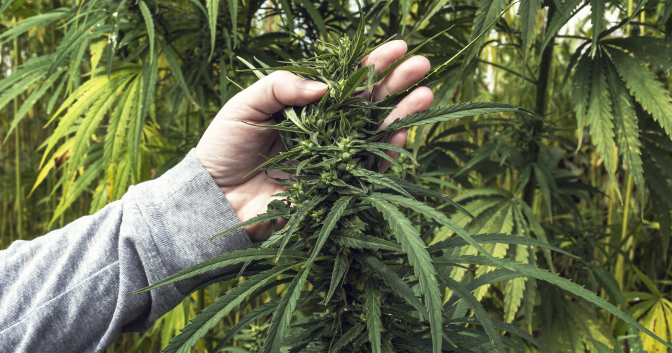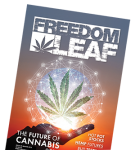Ed Rosenthal’s Wet and Dry Trimming Tips

Trimming marijuana is the preparation of the bud after it’s been cut from the plant. How and when buds are trimmed depends on the grower’s goals and strategy. The purpose of the marijuana harvest is to separate the highest-quality part of the plant, the ripe female flowers (buds), from the stems and leaves.
PARTS TO BE TRIMMED
The bud is the cannabis plant’s jewel. It’s a clutch of flowers that continues to grow for 6 to 12 weeks. The flowers squeeze tightly between and on top of one another, forming thick layers, until the entire group is a dense floral mass.
More than one bud grows on each branch. If buds grow large enough, they grow into each other, forming one continuous group called a “cola.” It’s always found on the outer extremity of the branch. The branch usually grows at nearly a 90° angle to the plant’s stem, although branches of some varieties may curve upward. Trimming starts with the removal of the branches from the main stem. From that point, the order of the trimming process varies greatly, but to create a fully manicured bud, it’s first clipped from the branch or cola. Then the fan leaves, trim leaves surrounding the buds and an extraneous material are removed.
What’s left is the manicured bud. Fan leaves contain small amounts of cannabinoids, and trim leaves contain a larger amount. Both are usually saved either for use or sale for extractions and concentrates.
TRIMMING STYLES AND STRATEGIES
There are many ways to trim. Style and method depend on the quantity and quality of the crop, goals and personal preferences. The biggest difference is between wet and dry trimming. This refers to the condition of the harvest, whether the material still contains the moisture it had as a living plant or whether it has been dried. The complexity of planning increases with the size of the crop.
De-leafing is the removal of the large fan leaves shortly before the marijuana harvest. Removal opens up the plant so sunlight can reach the buds. This enables the buds to grow and ripen faster and develop more potency. Harvesting will be easier without the bulky leaves.
WET TRIMMING
Wet trimming is a sticky, time consuming process, but it’s popular with growers who are concerned with processing their harvest quickly or have limited space to dry their crop. The process of trimming wet bud takes longer, but if a grower has an entire team of people standing by, she or he may not have the luxury of waiting for the entire crop to dry.
If you have a lot of material to process or don’t have a lot of manpower, then a wet trim is probably the safer option. If quality is your main priority and you have sufficient manpower, then a dry trim is recommended.
Pros:
• A naked bud takes less time to dry than a bud surrounded by leaves.
• Buds are dried in trays and on screens, which take less space than hanging whole stems.
• Wet trichomes are more pliant, so fewer snap off.
• Wet hand-trimming produces plentiful “finger hash”—hashish that’s ready to be smoked right off workers’ gloves or hands.
• The crop is processed as soon as it’s cut and is ready once it’s dried and cured.
• Wet-trimmed buds often have a “tidier” appearance than dry trimmed buds.
Cons:
• Wet hand-trimming is slower than dry trimming because the wet plant is pliant and harder to cut.
• The crew may need to be temporarily enlarged to trim the buds before they wilt.
DRY TRIMMING
Dry trimming is preferred by some producers, because dried buds are stiffer and easier to cut and handle. However, dry trichomes are brittle and break off easily during trimming. Collect them using screens and trays. This powder, called kief, can be smoked, sprinkled over bowls and into joints, pressed into hash or used for processing into extract.
Pros:
• Dry trimming is faster and easier than wet trimming. Rather than using scissors, gloved hands can simply snap off the brittle dried leaves.
• The only tasks essential to the harvest are to cut the buds, colas or whole plants, and provide them the proper environmental conditions to dry. A small crew will trim for a longer period after the harvest.
• Buds can be trimmed anytime they’re dry. There’s no immediate need for large crews working around the clock.
Cons:
• Buds allowed to dry on the stems with leaves attached dry more slowly and take up more space than buds that are manicured wet and dried on screens.
• More trichomes are lost to handling. Once the trichomes are dry and become brittle, they fall off buds more.
HOW TO HAND-TRIM
1. Install a clean table and adjustable-height chairs that comfortably place trimmers over the table, or use a trimming tray that sits on the lap.
2. Use gloves at all times.
3. Place a screen under the trimming area to collect trichomes. They fall off constantly during handling. Capture them using framed silkscreen or stainless-steel mesh. Prefabricated screens are available online or are easily made with a 100-micron-thick mesh fastened to a frame.
4. Disinfect transport bins and tools with hydrogen peroxide or alcohol. This helps prevent bacterial proliferation.
5. Arrange separate bins for mid-grade buds and for top buds, all other saleable buds, extractable material and trash. Only the top buds need to be manicured. The other material will be sold or used for processing.
6. Clip off the popcorn buds (also called larf). Place them in their own bin.
7. Trim the smaller, multi-fingered leaves surrounding the buds. They’re called sugar leaves or trim leaves. They’re also clipped off.
8. The bud should now appear almost naked, except for some single-fingered leaves sticking out from between the flowers as well as the few sugar leaves for protection. Watch out for buds that are much bigger than the others. They take longer to finish drying and are more susceptible to mold. They can be dried separately or broken down into smaller buds.
9. Collect trichomes from the table or trim bin.
10. Scrape finger hash from scissors.
11. Clean up.
TOP 3 ELECTRIC SCISSORS
If you’re a seasonal gardener, hand-trimming your buds might be the perfect reward for a season’s worth of hard work. However, labor-saving devices shorten the time it takes to perform these tasks. Electric scissors save hands, wrists and arms from repetitive stress while maintaining much of the control and the gentleness of hand trimming. About a dozen different types of electrical scissors and clippers are on the market. Here are three recommendations:
• The Bonsai Hero Handheld Electric Trimmer has two stationary blades and a double-edged swinging blade that’s constantly functioning. It allows the operator to trim two to three times faster than a manual trimmer.
• The Magic Trimmer is an affordable, corded, rotary-action electric trimmer that’s used to buzz leaves down—a faster process than clipping the leaf base.
• The Wander Trimmer is a corded electrical hand-trimmer with a suction hose that connects to any wet or dry vacuum. It promises 60%-70% faster trimming than scissors.
This article was excerpted from Marijuana Harvest: Maximizing Quality & Yield in Your Cannabis Garden. ©2017 Ed Rosenthal. Reprinted by permission of Quick American Publishing, Piedmont, CA.
If you enjoyed this Freedom Leaf article, subscribe to the magazine today!

